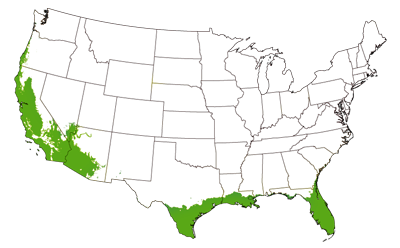Eureka Lemon Bush
Product Details
 Growing Zones 9-11
Growing Zones 9-11
| Soil Type | Acidic |
| Sunlight | Full |
| Drought Tolerance | |
| Mature Height | 15-20 Feet |
| Mature Width | 3-4 Feet |
| Growth Rate | Moderate |
| Shipping Restriction | AL, AZ, CA, FL, GA, LA, OR, TX |
What is the best place to plant my Eureka Lemon Tree?
This variety is water hungry but needs proper drainage. So make sure that you either plant on a slope or build up a large mound. Either of these will allow a sufficient amount of water to flow. They also require at least 10 hours of direct sunlight so choose an area with full sun and good drainage.
Should I be concerned with pruning my Eureka Lemon Tree?
These trees don’t require regular pruning like similar varieties. They should be pruned of any damaged or diseased sections. Overcrowded sections should also be trimmed away at your personal discretion.
Can I grow a lemon tree in a container?
Eureka Lemon Trees do remarkably well in containers. Ensure the container has proper drainage and is in a location that gets full sun for at least 10 hours a day.
Looking for beautiful, low maintenance additions for your garden, well look no further. These vibrant trees need 10 plus hours of direct sunlight daily. The acidic fruit loves acidic soil. Keeping the pH between 6 and 6.5 is ideal for having a bountiful year-round harvest.
These are not winter hardy trees so if the temperature drops below 20 degrees then container planting is recommended so that they can be moved inside during the winter.
Planting
The simple beauty of the Eureka Lemon Tree adds magnificence to any garden. Plant on a slope or build up a tall mound so that water will drain properly. These natives of California love to soak in the sun. So make sure they will get at least 10 hours of full sun daily. Zones 9, 10, and 11 are ideal locations for healthy bountiful harvests. Lemon trees are self fertile, however if multiple trees are planted they should be spaced at least 8 feet apart, and clear of any structures.
Watering
Water the soil often enough to keep it consistently moist. Mulch should not be applied because it will cause the ground to retain too much water and cause the roots to become waterlogged.
Fertilizing
As a year-round highly productive source of vitamin C, these beautiful acid loving trees are always hungry. Adding a bi-annual feed and fertilizer mix specifically designed for citrus trees will provide extra nutrients needed to continue the hearty rate of production. Fertilizer should be applied once in late winter, as well as in June and also August.
Maintenance
Eureka Lemon Trees can reach a maximum height of 20 feet, which can create difficulty in harvesting their highly-textured, thick-skinned, fruit. Frequent pruning allows for easier access during harvest. Whether you decide to allow this open spreading tree to reach its full height or decide to prune it back for easy access, make sure to trim back or remove damaged, diseased, and overcrowded sections. This improves the visual appearance of your tree but also encourages healthy growth.









